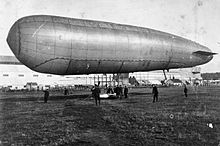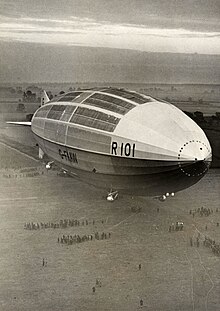User:Rodburgess/sandbox
User:Rodburgess/Airship ground handling
Because of their size, mass and bouyancy, the ground handling of airships on the ground presents unique problems. The immense forces exerted by even a light breeze require adequate arrangements to be made for restraining, controlling and manoeuvring a ship from the time it lands until the moment it takes off. Various methods and techniques have been tried, some more successful than others, ranging from man-power to complex mechanical systems. For all but the shortest sojourns on the ground, some form of mooring has been shown to be necessary. For longer stays, and for maintenance and repair, a hangar or shed is required.
The problem
[edit]Once inside a shed with the doors closed, an airship is no longer at the mercy of the weather, although actually entering and exiting the shed is problematical. Sheds will be considered later. On the ground but outside the shed , the problems of control and restraint of an airship can be considered in terms of three distinct tendencies:
- The tendency of the ship either to float upwards or sink downwards, according to its static lift versus its weight.
- The tendency of the ship to blow away, directly downwind.
- The tendency of the ship to yaw, ie to turn its head out of the wind or to weathercock into the wind.
When the static (gas) lift of an airship exactly equals its weight it is said to be "in equilibrium" (or, colloquially, "at EQ"). In this condition, it will tend neither to rise or sink. Static lift can be reduced by valving off lifting gas, effectively making the ship heavier, while weight can be reduced by dropping ballast. Historically blimps, being smaller and generally relying more on manpower, have been ballasted slightly heavy for take-off and landing (and thus tend to sink to the ground, making the ground crew's task easier), while large rigid ships were slightly light (and had to be hauled down to the mooring mast by powered winches).[1] In some cases, vectored thrust is available to provide an artificial adjustment of effective weight, notable examples being the USS Akron and Macon and the Airship Industries 500 and 600.
An aeroplane at rest on the ground is held in place by its weight and by the friction between its undercarriage and the surface upon which it rests. Only in the very most extreme wind speeds is it likely to blow away unless safely tucked away inside a hangar. Not so for any lighter-than-air aircraft. Although it has mass, its bouyancy means that its effective weight is close to zero. The slightest gust of wind will cause it, unless restrained, to drift across the landing field.
The requirements of control in flight mean that an airship is designed to be marginally unstable in yaw.
The early days
[edit]Early airships were small enough that a small ground crew could control them.


References
[edit]- ^ Goodyear Aerospace Corp (March 1981). Study of Ground Handling Characteristics of a Maritime Patrol Airship (PDF). San Francisco, California: NASA. Retrieved 1 March 2015.

